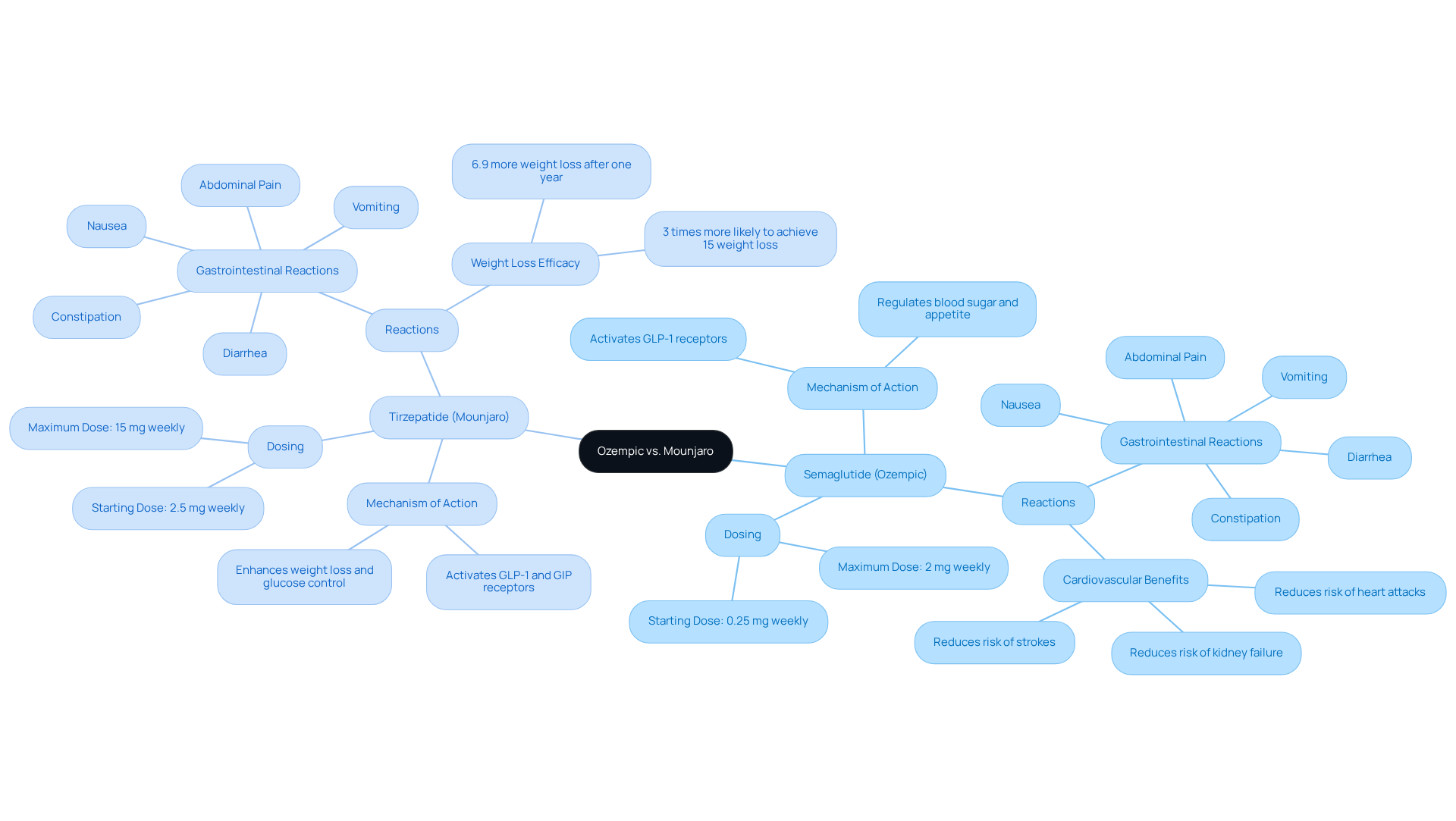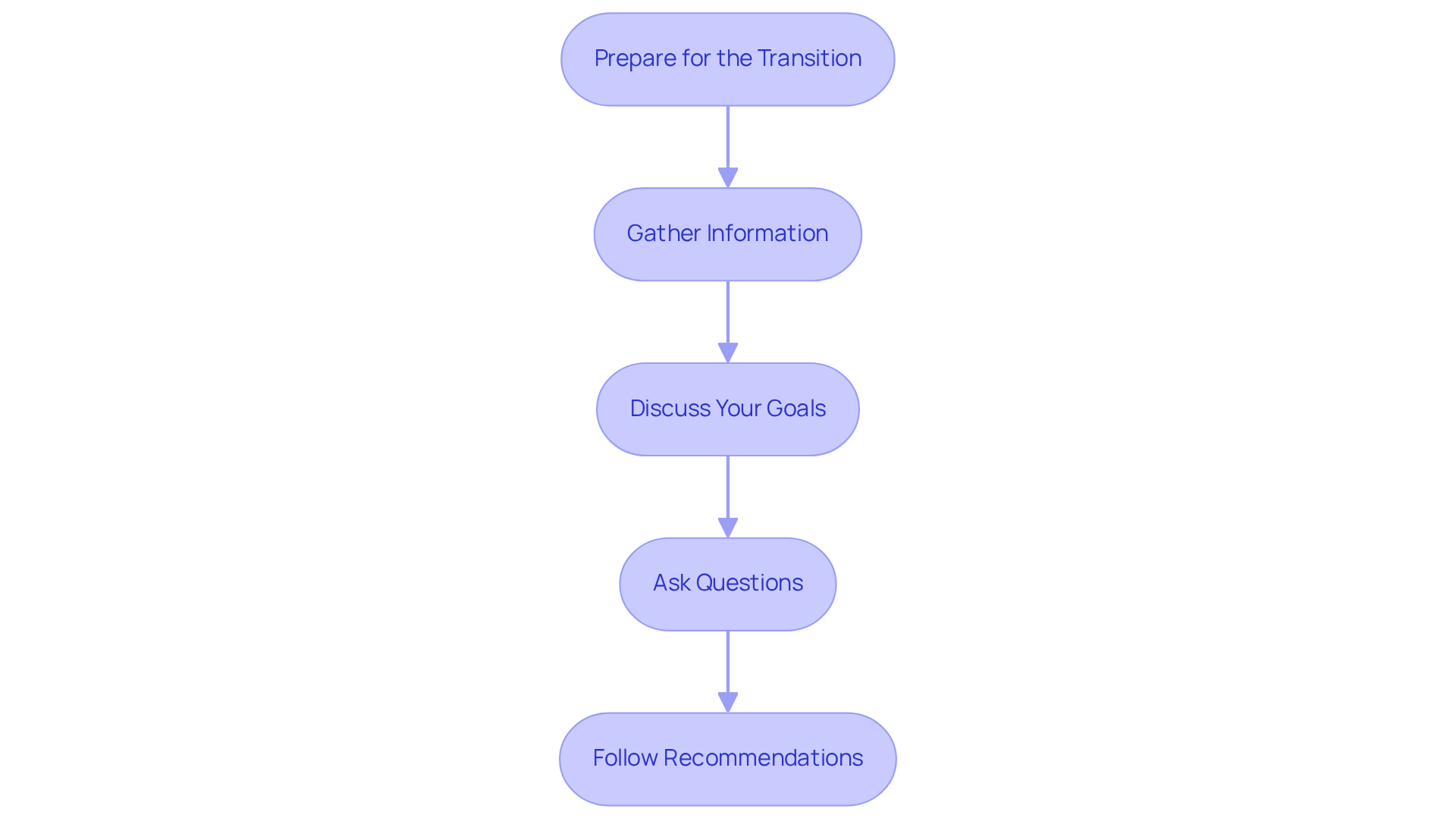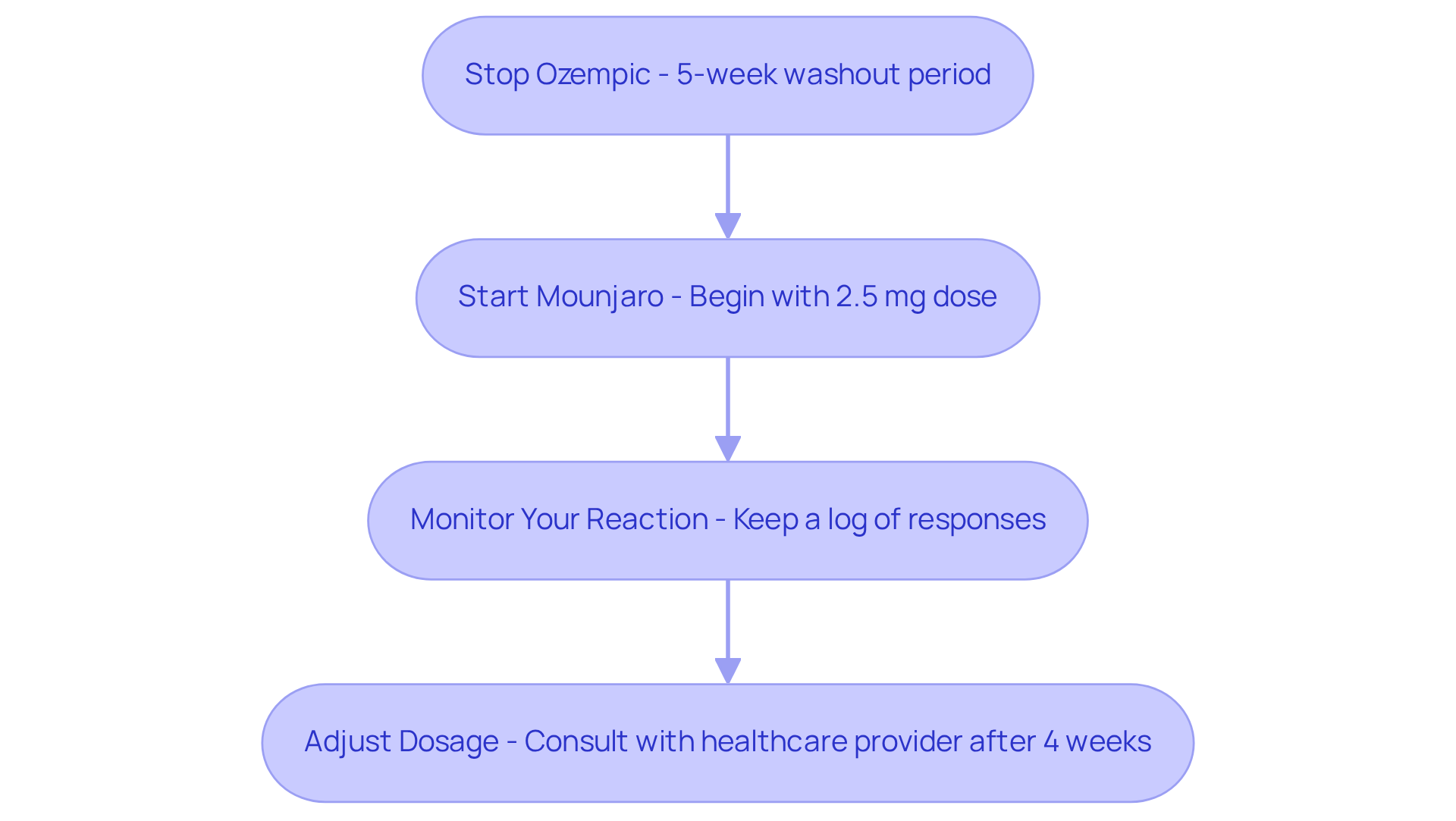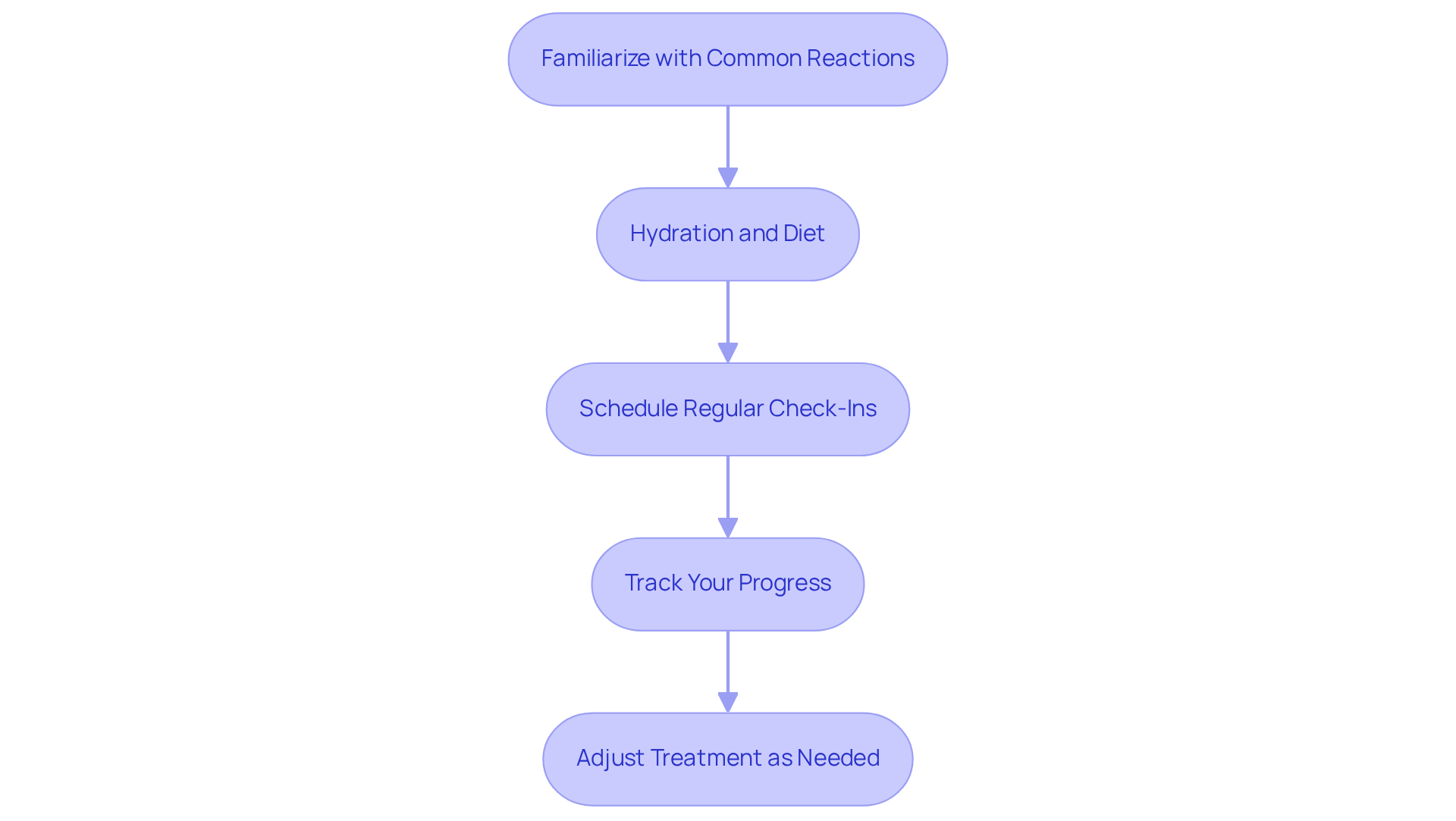Overview
This article serves as a compassionate guide for those considering the transition from Ozempic to Mounjaro. We understand that navigating this journey can feel overwhelming, and it’s crucial to consult with a healthcare provider throughout this process. By following a structured step-by-step approach, you can feel more confident in making this change.
We’ll explore the differences between Ozempic and Mounjaro, including their dosing regimens and potential side effects. It’s important to monitor your progress closely to ensure a safe and effective conversion. Remember, you are not alone in this journey; together, we can achieve your goals and help you feel your best.
Introduction
Navigating the complexities of diabetes management can feel overwhelming, especially when it comes to making informed decisions about medication options. As you explore alternatives to Ozempic, consider the transition to Mounjaro. This shift presents a unique opportunity to enhance both weight loss and blood sugar control. However, we understand that the process can be daunting, raising important questions about how to ensure a smooth and safe switch.
What steps can you take to maximize the benefits of this change while minimizing potential side effects? Together, we can explore these questions and find the best path forward.
Understand the Differences Between Ozempic and Mounjaro
If you’re navigating the complexities of type 2 diabetes and weight loss, understanding your options is crucial. Semaglutide and tirzepatide, both GLP-1 receptor agonists, offer unique benefits that can support your journey.
-
Mechanism of Action: Semaglutide primarily activates GLP-1 receptors, which are vital for regulating blood sugar levels and appetite. On the other hand, tirzepatide targets both GLP-1 and GIP receptors, which may enhance weight loss and improve glucose control. Research indicates that participants using tirzepatide lost 6.9% more weight after one year compared to those on other medications. While semaglutide is FDA-approved for type 2 diabetes treatment, it is also prescribed off-label for weight loss.
-
Dosing: Semaglutide is typically administered once weekly, starting at 0.25 mg, with a maximum dose of 2 mg. Meanwhile, tirzepatide begins at 2.5 mg weekly, with the potential to increase up to 15 mg. This flexibility allows healthcare providers to tailor the dosage to meet your individual needs.
-
Reactions: It’s important to be aware that both medications can cause gastrointestinal reactions, such as nausea, vomiting, diarrhea, constipation, and abdominal pain. However, tirzepatide’s dual-action mechanism may lead to a different profile of adverse reactions. Studies indicate no significant difference in the incidence of moderate to severe gastrointestinal events between the two, suggesting that you may not experience increased side effects with tirzepatide despite its broader receptor activity. Additionally, while semaglutide has shown a reduction in the risk of heart attacks, strokes, and kidney failure, these benefits for tirzepatide are still being evaluated.
Understanding these differences is essential as you consider the ozempic to mounjaro conversion. Such a decision can significantly impact your weight loss journey and overall health outcomes. We encourage you to consult with your healthcare provider to see if tirzepatide is right for you. Remember, discussing all medications and supplements you are taking is vital to avoid potential interactions. Together, we can navigate this path towards better health.
Prepare for the Transition: Consult Your Healthcare Provider
Before altering your medication regimen, it’s essential to consult with your healthcare provider. This conversation can feel overwhelming, but we’re here to guide you through it. Here’s how to prepare effectively for this important discussion:
- Gather Information: Start by compiling a comprehensive list of your current medications, including dosages and any reactions you’ve experienced. This information will help your provider understand your situation better and tailor their advice to your needs.
- Discuss Your Goals: Clearly express your reasons for wanting to undergo an ozempic to mounjaro conversion. Whether it’s due to reactions, effectiveness, or personal preference, sharing your objectives will steer the conversation in a productive direction.
- Ask Questions: Don’t hesitate to inquire about the expected timeline for the transition, potential side effects of the new medication, and any necessary lifestyle or dietary adjustments. Understanding these factors is crucial for a successful ozempic to mounjaro conversion.
- Follow Recommendations: Your healthcare provider may suggest a specific timeline for stopping the medication and starting the alternative. Adhering to this guidance is vital for ensuring a smooth transition and minimizing any risks associated with medication changes.
It’s important to recognize that nearly 40% of Type 2 diabetes patients discontinue their second-line medications, often without consulting their doctors. This statistic highlights the importance of ongoing communication about medication management. As Elise S. Tremblay, MD, MPH, notes, “Targeted policies and further research are needed to tackle insulin costs and use disparities.” This emphasizes the need for patients to engage in discussions about their treatment options.
Engaging in a thorough discussion with your healthcare provider can significantly enhance your treatment experience and outcomes. Remember, together, we can achieve your goals. Discontinuing second-line diabetes medications can increase the risk of downstream hospitalizations related to diabetes, so let’s take this step together for a healthier future.
Follow the Step-by-Step Process to Switch from Ozempic to Mounjaro
Transitioning from one medication to another, such as the ozempic to mounjaro conversion, can feel overwhelming, but with a thoughtful approach, you can ensure both safety and effectiveness. Here’s a step-by-step guide to help you through this process:
- Stop Ozempic: After your last dose of Ozempic, it’s important to allow about 5 weeks for the medication to clear from your system, as your healthcare provider recommends. This washout period is crucial for minimizing potential adverse reactions during the ozempic to mounjaro conversion.
- Start the new medication: Begin treatment with the lowest dose, usually 2.5 mg. This is given as a once-weekly injection under the skin of your stomach, thigh, or upper arm. Remember to inject it on the same day each week and adhere to all dosage guidelines provided by your doctor. Starting conservatively helps reduce the chances of any adverse reactions.
- Monitor Your Reaction: Keep a detailed log of how your body responds to the medication, noting any side effects, weight changes, and fluctuations in blood sugar levels. This information is vital for your healthcare provider to tailor your treatment to your needs.
- Adjust Dosage: After 4 weeks, it’s time to check in with your healthcare provider to assess your progress. Depending on how you’re feeling, your dosage may be adjusted every 4 weeks, with a maximum limit of 15 mg, to help you achieve the best possible results.
Many patients have shared their experiences during the ozempic to mounjaro conversion. While some may encounter mild gastrointestinal reactions, these typically resolve within a few weeks. Experts highlight the significance of personalized care during this time, ensuring that any adjustments align with your health goals and comfort. Remember, you’re not alone in this journey; together, we can navigate these changes and work towards your well-being.
Manage Side Effects and Monitor Your Progress
Transitioning to Mounjaro can feel overwhelming during the ozempic to mounjaro conversion, but with careful management of side effects and diligent progress monitoring, you can navigate this journey with confidence.
-
Common Reactions: It’s important to familiarize yourself with potential reactions, such as nausea, vomiting, diarrhea, and reduced appetite. These are common experiences shared by those undergoing the ozempic to mounjaro conversion.
-
Hydration and Diet: Prioritizing hydration and opting for smaller, more frequent meals can significantly alleviate gastrointestinal discomfort. By steering clear of high-fat and high-sugar foods, you can enhance your comfort during this transition.
-
Regular Check-Ins: We encourage you to schedule ongoing follow-up meetings with your healthcare provider. These meetings are crucial for assessing your progress and discussing any concerns. This proactive approach enables timely adjustments to your treatment plan, ensuring you achieve the best possible results.
-
Track Your Progress: Keeping a detailed journal to document your weight, blood sugar levels, and any side effects is invaluable. This record will empower your healthcare provider to tailor your treatment effectively, supporting you every step of the way. Remember, together, we can achieve your goals!
Conclusion
Navigating the transition from Ozempic to Mounjaro is a pivotal step for individuals managing type 2 diabetes and seeking effective weight loss solutions. It’s important to understand the distinct mechanisms of action, dosing strategies, and potential side effects of these medications to make informed decisions. This guide emphasizes thorough preparation and consultation with healthcare providers to ensure a seamless transition that prioritizes safety and effectiveness.
Have you considered how Ozempic and Mounjaro differ in their functions? Understanding these differences is crucial, as is recognizing the significance of a proper washout period and the necessity of monitoring reactions during the conversion process. Engaging in open dialogue with healthcare professionals, tracking your progress, and managing side effects are vital components that enhance your overall treatment experience. By following a structured approach, you can optimize your outcomes and navigate this journey with confidence.
Ultimately, the transition from Ozempic to Mounjaro represents a proactive step toward better health management. It is essential to prioritize communication with your healthcare providers, stay informed about potential side effects, and actively monitor your progress. Embracing this journey not only supports your personal health goals but also contributes to a broader understanding of effective diabetes management strategies. Together, we can take charge of your health today by initiating discussions with your provider and exploring the best options tailored to your needs.
Frequently Asked Questions
What are the main differences between Ozempic and Mounjaro?
Ozempic (semaglutide) primarily activates GLP-1 receptors to regulate blood sugar and appetite, while Mounjaro (tirzepatide) targets both GLP-1 and GIP receptors, potentially enhancing weight loss and glucose control.
How do Ozempic and Mounjaro affect weight loss?
Research indicates that participants using Mounjaro lost 6.9% more weight after one year compared to those on other medications. Semaglutide is also prescribed off-label for weight loss.
What are the dosing schedules for Ozempic and Mounjaro?
Ozempic is administered once weekly, starting at 0.25 mg and can go up to a maximum of 2 mg. Mounjaro starts at 2.5 mg weekly, with the potential to increase to 15 mg.
What side effects are associated with Ozempic and Mounjaro?
Both medications can cause gastrointestinal reactions such as nausea, vomiting, diarrhea, constipation, and abdominal pain. However, studies suggest no significant difference in the incidence of moderate to severe gastrointestinal events between the two.
Are there any cardiovascular benefits associated with these medications?
Semaglutide has shown a reduction in the risk of heart attacks, strokes, and kidney failure, but the cardiovascular benefits of tirzepatide are still being evaluated.
Should I consult my healthcare provider about switching from Ozempic to Mounjaro?
Yes, it is important to consult with your healthcare provider to determine if tirzepatide is right for you and to discuss all medications and supplements you are taking to avoid potential interactions.





















